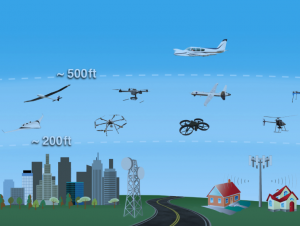
NASA has been working with commercial technology partners for years to develop a working UTM system. The program has been successfully tested and is inching forward. But a new drone study – “The Market for UAV Traffic Management Services” published by Unmanned Airspace (www.unmannedairspace.info) – predicts that the UK, Singapore, Dubai and others will beat the U.S. to implementing a UTM system.
“The UK is around two years ahead of the European Union’s UTM strategic U-Space plan and has already developed the core components of such a network,” says Philip Butterworth-Hayes, one of the authors of the report. “But Japan and South Korea are close behind the UK. Dubai and Singapore will be the first countries to develop urban commercial drone transport systems, including passenger taxi services.”
A working UTM system is critical for full drone integration and implementation of major commercial drone applications like drone delivery, BVLOS applications, and the use of drones in urban air mobility planning.
The study, which includes a global view of UTM development plans, a timetable for commercial drone-service implementation dates, a country-by-country analysis of current commercial drone operations, a report on UTM financing options and a review of UTM technology programs and business opportunities, concludes that the US is behind the curve on both UTM and the implementation of many commercial applications.
“The first operational UTM services, such as drone registration, geo-fencing, and electronic identification measures, will be launched in 2019 and we expect UTM operators will receive around USD 32 million in the first year from commercial drone operator fees and investment from governments and research agencies to provide these services,” says Philip Butterworth-Hayes.
Interestingly, the report also concludes that the industry, rather than government, is likely to end up paying for a UTM system. “With many UTM models based on the principle that the user pays – rather than the taxpayer – it is the commercial drone community that will find itself having to finance the UTM system,” says the study. ” The development of algorithms to calculate the risk of a flight and generate insurance coverage per operator, per flight, could also be used to generate UTM service charges based on the length and complexity of the flight.” The author says that business models and commercial applications available in each country are tied together.
“…the business models still have to be worked out and will depend on how commercial drone operations are developed,” says Butterworth-Hayes. “For many governments the prospect of small drones delivering packages to individual households and offices in city-centres is a non-starter. There are just too many issues around privacy, safety and environmental protection to consider. Far more likely will be the appearance of large bulk-carrying drones flying freight to regional distribution centres with the last mile deliveries taking place by more traditional means.”

Miriam McNabb is the Editor-in-Chief of DRONELIFE and CEO of JobForDrones, a professional drone services marketplace, and a fascinated observer of the emerging drone industry and the regulatory environment for drones. Miriam has penned over 3,000 articles focused on the commercial drone space and is an international speaker and recognized figure in the industry. Miriam has a degree from the University of Chicago and over 20 years of experience in high tech sales and marketing for new technologies.
For drone industry consulting or writing, Email Miriam.
TWITTER:@spaldingbarker
Subscribe to DroneLife here.